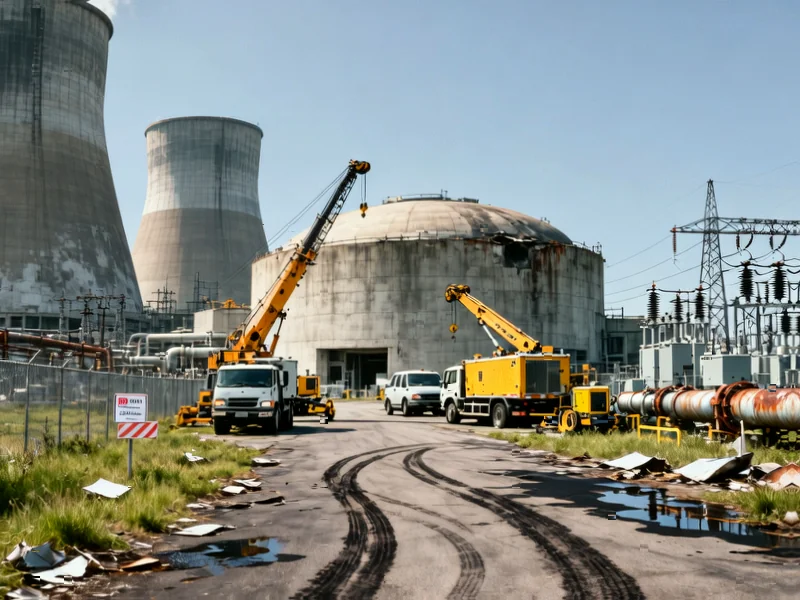According to The Verge, Google announced a 25-year agreement with NextEra Energy to purchase electricity from the Duane Arnold Energy Center, a 615MW nuclear plant in Iowa that ceased operations in 2020. The company revealed in a blog post that it’s “enabling the investment to restart the plant and covering costs for the production of energy” with plans for the facility to resume operations by 2029. Central Iowa Power Cooperative will purchase remaining electricity not used by Google. This follows Microsoft’s similar move last year to help revive a reactor at Three Mile Island, scheduled for 2028 operation, as tech companies increasingly turn to nuclear energy to meet AI’s massive electricity demands.
Table of Contents
The Unprecedented Technical Hurdles
What Google and NextEra are attempting has never been done successfully in the United States – restarting a fully decommissioned nuclear facility. The technical challenges are monumental. Nuclear plants aren’t like conventional power stations that can be simply turned back on after years of dormancy. Critical components including reactor vessels, steam generators, and cooling systems undergo degradation that requires extensive inspection, replacement, and recertification. The nuclear regulatory framework wasn’t designed for restart scenarios, meaning every step will require novel approval processes from the Nuclear Regulatory Commission. The 2029 operational target seems optimistic given these unprecedented regulatory and technical hurdles.
AI’s Insatiable Power Demand
This move underscores a fundamental reality about artificial intelligence that many outside the industry don’t appreciate: AI models are incredibly energy-intensive. Training large language models like GPT-4 consumed estimated electricity equivalent to powering thousands of homes for a year. More concerning is inference – the ongoing electricity required every time someone uses an AI tool. As Google integrates AI across Search, Workspace, and cloud services, its power requirements are scaling exponentially. Traditional data center power solutions simply can’t keep pace, forcing radical approaches like nuclear restarts.
The Big Tech Energy Arms Race
Google’s announcement signals an emerging pattern among Big Tech companies who are essentially becoming energy companies in disguise. Microsoft’s Three Mile Island initiative, Amazon’s massive renewable energy purchases, and now Google’s nuclear revival represent a fundamental shift in how tech giants approach their infrastructure. They’re no longer content to simply purchase power from utilities – they’re actively shaping energy generation to meet their specific reliability and carbon-free requirements. This creates both opportunities and concerns for traditional energy markets and regional grids.
Regional Economic Transformation
The revival of Duane Arnold represents more than just an energy story for Iowa – it’s an economic development catalyst. A nuclear facility restart brings high-skilled jobs, tax revenue, and infrastructure investment to the region. However, it also raises questions about energy equity. When a tech giant effectively commandeers a significant portion of a region’s power generation capacity, what happens to local businesses and residents who may face competition for remaining electricity? The arrangement with Central Iowa Power Cooperative to distribute unused power helps, but the fundamental power dynamics have shifted.
The New Energy Paradigm
Looking forward, this deal could establish a template for how energy-intensive industries approach their power needs. If successful, we may see more companies following Google’s lead in partnering with energy providers to revive dormant assets. The combination of next-generation nuclear development through partnerships like Google’s work with Kairos Power, plus strategic restarts of existing facilities, creates a multi-pronged approach to solving the energy availability crisis. However, the success of this model depends entirely on whether Google and NextEra can actually deliver on their ambitious 2029 timeline and make the economics work for what will undoubtedly be a massively expensive undertaking.
Related Articles You May Find Interesting
- Teradyne’s AI-Driven Surge Masks Deeper Market Realities
- The AI Authorship Crisis: Why Human Judgment Needs Digital Verification
- YouTube’s Windows 11 Crackdown Sparks Creator Exodus Fears
- The Hidden Cost of Rude AI: Why Being Mean to ChatGPT Works
- The AI Capex Divide: Smart Spending vs. Speculative Gambles



